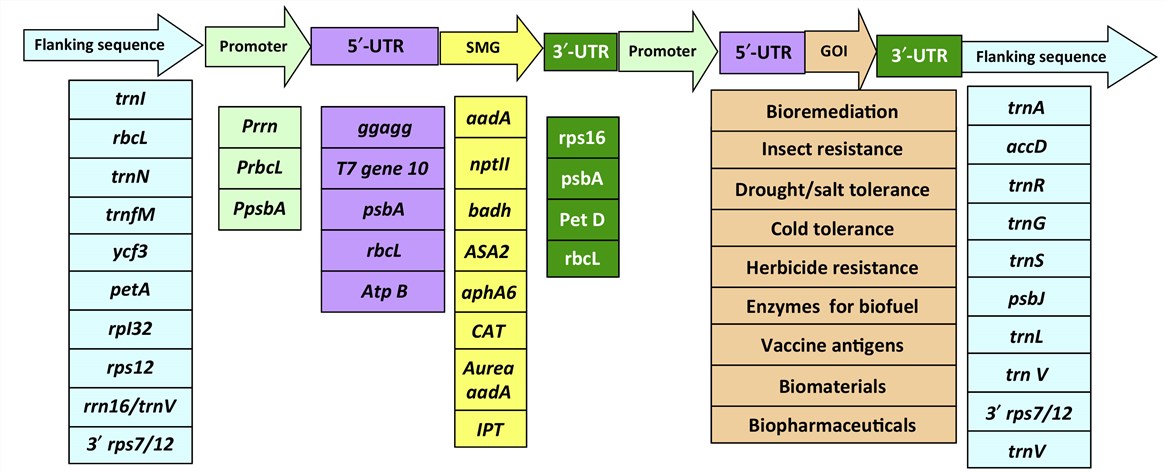Chloroplast Genetic Engineering System for Vaccine Production
Growing Creative Biolabs led a professional R & D team to master the vaccine and accumulated rich experience in the development and production of vaccines, focusing on cutting-edge technology in vaccine development, while continuing to innovate and evolve existing technologies makes us situated in the leading position in vaccine industry. We have a rich and complete research and development system, the ability to solve all problems you met. In terms of vaccine expression, we are constantly improving and enriching our service system and will spare no effort to serve for you.
chloroplast Expression Systems
By far, nearly 50 recombinant subunit vaccine candidates have been produced in chloroplast expression systems. The chloroplast genetic engineering technology has many advantages, including high-level expression of the target gene, single transformation of multiple genes, maternal inheritance of the transgene, and avoidance of gene silencing and site effects. Due to maternal inheritance, chloroplast expression is largely less risky for transgenic crops to transfer foreign genes to other crops through pollen. These characteristics enable the chloroplast genetic engineering system a promising technology to produce vaccines against bacteria, virus and other pathogens.
Nuclear transgene integration usually occurs through non-homologous recombination, while chloroplast genome transformation can only be achieved by homologous recombination, and the insertion site of the target gene is critical for gene expression levels. There are two integration sites that are frequently used, one in the operon in the transcriptionally active spacer of the same strand and the other in the transcriptionally silent spacer in the opposite strand. Among them, the most widely used site is trnA / trnI in the 16S rRNA operon of the chloroplast genome, and the regions presenting a lower expression level between rbcL and accD are also used.
 Fig. 1 Schematic representation of the chloroplast vector. 1,2
Fig. 1 Schematic representation of the chloroplast vector. 1,2
The most commonly used transformation methods for obtaining stable plastids are the biolistic and the PEG method. Biolistic is time-efficient, easy to manipulate and express antigens at high level, leading to its wide application. The PEG method is commonly used to introduce biologically active DNA into the plant nuclear genome, as well as for chloroplast transformation. The chloroplast transformation process is usually divided into four steps: 1) The transformation vector carrying the foreign gene is introduced into the chloroplast by a gene gun or other transformation system. 2) The exogenous gene expression frame is integrated into the chloroplast genome by homologous recombination. 3) Screening for successfully transformed chloroplast cells. 4) Subculture to obtain stable chloroplast transformed plants.
 Fig. 2 Examples of components commonly used in chloroplast vector. 1,3
Fig. 2 Examples of components commonly used in chloroplast vector. 1,3
Selectable Markers
The plastids that are successfully inserted into the gene of interest are selected for enrichment to achieve homogeneity, which is critical for the stable expression of the transgene. Generally, homoplasmy is accomplished through several rounds of selection on antibiotic-containing media. And aadA is the most commonly used selectable marker (SM) gene, conferring resistance to spectinomycin and streptomycin, which are specifically inhibit plastid translation. However, the increasing concern of safety, especially for vaccines, arose the interest in developing antibiotic-free selectable markers. Antibiotic-free selectable markers available are only appropriate for the second round of selection. Another strategy is to excise marker gene through direct repeat-mediated recombination or using CRE-lox system. Besides, site-specific Bxb1 recombinase could excise DNA from the plastid genome in the trnI/trnA region, showing a huge potential in chloroplast transformation application.
Strategies to Improve Immunogenicity of Chloroplast-Made Vaccines
- Conjugation or fusion expression
- Adjuvant
- Freeze-drying and batch processing
Services
- Design and construct of expressing vector
- Construct and screening for stable chloroplast transformed plants
- Production of subunit vaccines
- Immunogenicity evaluation of the vaccine candidate
- Production of vaccines in accordance with GMP regulations
Creative Biolabs is a professional expert in vaccine development with a variety of mature and comprehensive platforms and technologies for the evaluation and improvement of vaccine expression systems especially in chloroplast genetic engineering system, we are well equipped to handle all matters you are suffering and provide you the best services!
References
- Jin, Shuangxia, and Henry Daniell. "The engineered chloroplast genome just got smarter." Trends in plant science 20.10 (2015): 622-640.
- Image retrieved from Figure 1 "The Art of Chloroplast Genome Engineering". Jin, Shuangxia & Henry Daniell, 2015, used under CC BY 4.0, The original image was modified by extracting and using only part (A) and the title was changed to "Schematic representation of the chloroplast vector".
- Image retrieved from Figure 1 "The Art of Chloroplast Genome Engineering". Jin, Shuangxia & Henry Daniell, 2015, used under CC BY 4.0, The original image was modified by extracting and using only part (B) and the title was changed to "Examples of components commonly used in chloroplast vector".
All of our products can only be used for research purposes. These vaccine ingredients CANNOT be used directly on humans or animals.


